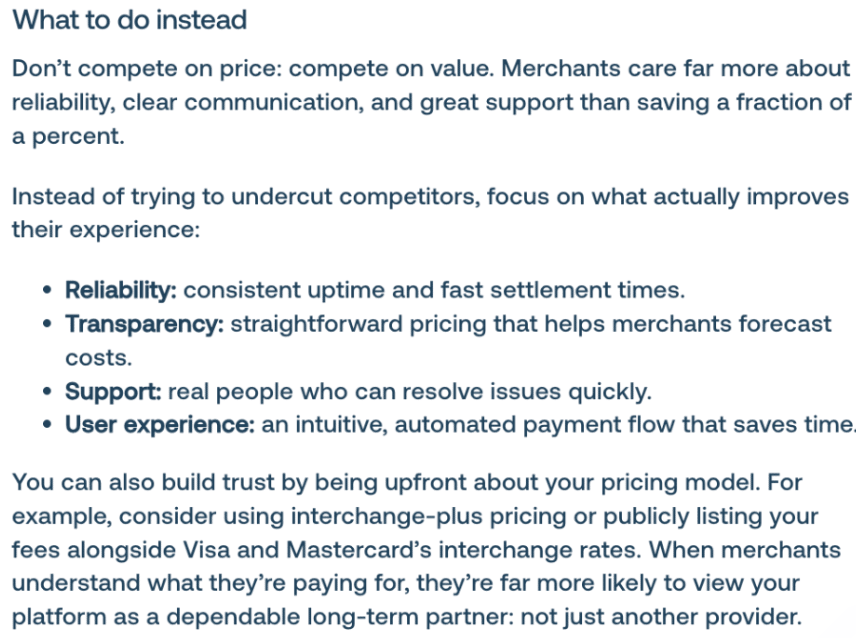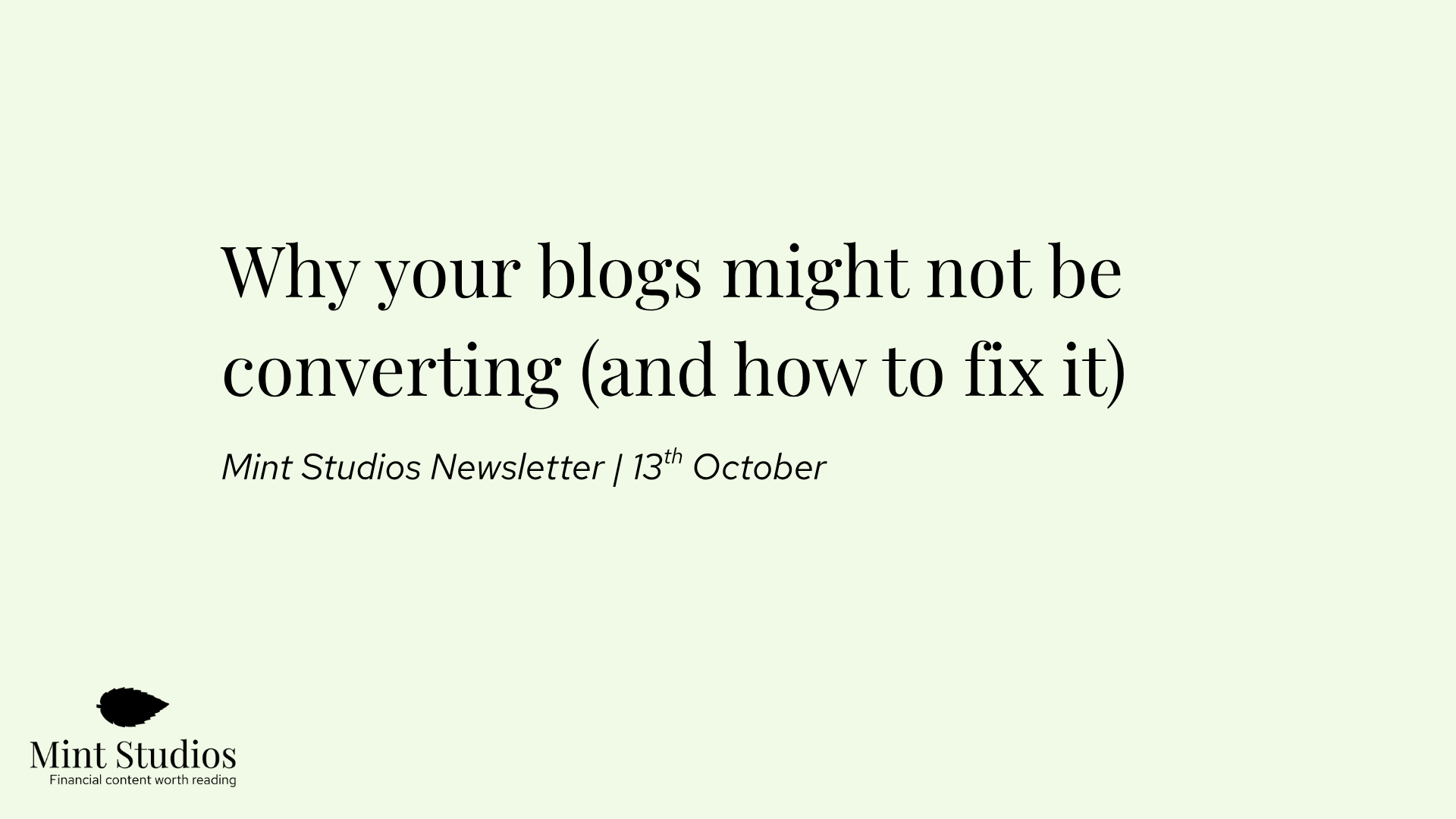Hey folks,
Elliot here.
Today, I want to talk about something that sits at the heart of how we create content at Mint: why it’s worth creating content based on interviews with subject-matter experts.
A good interview is often the difference between content that brings in new, high-quality customers and content that just sounds like everyone else.
Writers can research the market, understand the audience, and analyse competitors… but it’s impossible to truly capture the full picture without talking to the people who live it every day. The engineers, sales reps, and founders hold insights that don’t always make it into decks or websites. This is the kind of content that builds trust in your brand, and that trust is what turns prospects into customers.
So, let’s look at why those conversations matter so much and some tips for conducting these interviews.
A real example of how an interview can add insights you can’t get from desk research
Firstly, let’s look at what the benefit of interviewing SMEs actually looks like with an example from a real client.
Fiska is an embedded payments platform operating across North America. Their website is still relatively young, and we’re in the early stages of building out SEO content. We identified an opportunity for a piece on how SaaS platforms can monetise payments.
We spent 30 minutes interviewing Patrick Huynh, Fiska’s CEO, and used his product knowledge and industry experience as the backbone of the content.
Thanks to this, we were able to add information that we would never have gotten from desk research alone.
For instance, in one section of this blog, we talk about common mistakes that SaaS platforms often make when it comes to payments.
From desk research, we might have identified that lower pricing is not always attractive to merchants:

However, the next section on what merchants should actually do is advice only someone with actual industry experience can offer: someone who has worked directly with SaaS platforms:

For instance, “publicly listing your fees alongside Visa and Mastercard’s interchange rates” is not an insight we would have surfaced with desk research alone. It’s strategic advice from an industry expert who has seen this tactic work. This adds depth to the content, making it far more helpful than shallow blogs that only spell out the obvious.
It’s this level of depth that can build more trust in your brand and, subsequently, drive more leads. If readers see your brand as an authority that offers genuinely helpful information, they are far more likely to reach out.
Here’s an example from another client that demonstrates how blogs based on interviews can actually bring in leads:
For one client, we created a founder story article that explored how the company was built and the problem it set out to solve. That single piece generated more leads in one month than any other article on their site: simply because it offered genuine insight and perspective that only the founder could provide.

Common objections to SME interviews (and why we do them anyway)
For every client we work with, we interview their experts. We sometimes get pushback from teams who aren’t sure whether expert interviews are worth it.
Here are the most common objections we hear, and why we still recommend doing the interview:
- “The expert doesn’t have time.”
We only ask for 30 minutes, and we come fully prepared. One short call can fuel multiple pieces of content and save hours of back-and-forth later. - “The expert might not see it as important.”
Before we conduct an interview, we always provide the SME with the rationale for our strategy and explain how this piece of content could actually generate leads. In most cases, this gets the expert on board and happy to help! - “The content will sound too salesy.”
Interviewing an SME for content is not a transcription exercise. We don’t take exactly what they say: we know how to take sales messaging, pull out the real value behind it, and weave it into a piece in a subtle, strategic way. The result feels helpful rather than overly promotional.
On the flipside, not interviewing SMEs can lead to content that is
- Generic and forgettable: The content ends up sounding like everything else on the SERPs. There is no real insight that the reader can’t get from a competitor’s blog.
- Missing nuance: Fintech and financial services are full of nuance: regulatory nuance, payment semantics, and high-pressure infrastructure decisions. Without expert input, it’s easy to oversimplify or miss out important details.
- Not quite aligned with the ICP: Most fintechs sell to more than one type of customer, each with their own priorities and language. Without input from someone who actually speaks to those users day to day, your content can end up sitting awkwardly in the middle: the information is technically correct, but not quite clicking with the reader’s specific pain points.
How to interview your experts effectively
Here’s how to make sure your interview is useful:
- Interview the right people: Not all experts are comfortable in an interview. Try to lean on SMEs who not only know the product but also get excited about it, offer useful insights, and can explain the processes simply.
- Ask the right questions: If you’ve got 30 minutes, don’t spend half of it covering basics that you could’ve learned from desk research. Use SME time for the insight only they have access to, or for concepts that you just can’t get your head around.
Useful angles to explore include:- Real customer stories and outcomes
- What users love most (and why)
- Why customers choose you over alternatives
- Honest drawbacks or trade-offs of your product
- What are their pain points on this specific topic
- Respect their time and energy: Send a few discussion points a day or two beforehand. No heavy preparation required: the aim is simply to avoid surprises and give the SME a sense of direction.
During the call, guide the conversation, keep it structured, and be mindful of time. If you need to extend, ask before continuing. A clear, respectful process increases the likelihood they’ll participate again. - Document and reuse effectively: Record and transcribe the conversation. Store these centrally so they can support multiple pieces of content and future briefs. A single conversation could provide more ideas for future content, as well as enough substance for multiple BOFU articles, GPT articles, and even shorter form content like LinkedIn posts.
- Share leads with your SMEs: If you notice that content that your SME helped with has brought in a lead, share the win with them! It’ll motivate them to keep helping with content.
- Put their name on the article: Another great way to get SME buy-in is to actually put their name on the article. This motivates them to help us create a really strong piece of content, as it reflects well on them (and the wider brand). It also helps demonstrate experience and authority, which supports Google’s E-E-A-T signals.
The takeaway: genuine insight from SMEs builds credibility, and credibility drives conversions
It can be tempting to rely solely on desk research. But in a world flooded with AI slop and generic content, the need for quality has never been higher. If your content doesn’t stand out as genuinely helpful, your prospects won’t read it. And if they’re not reading it, what’s the point in creating it?
If you want content that actually earns attention, it needs to be insightful, interesting, and grounded in real experience. That’s why we always recommend starting with the people who know your product best.
A short expert conversation gives you the language, proof points, and depth that no amount of desk research can match. When readers sense that experience behind your content, they trust you faster. And that trust is what turns attention into leads.
Mint Recommended Reads
- Why You Should Create Content Based on Interviews With Experts
- What Good BOFU Content Looks Like (And Tips on Creating it)
- Case Study: How Content Helped a Niche Financial Company Grow Website Inbound Enquiries by 58%
Thanks for reading,
Elliot & the Mint team 🎉










